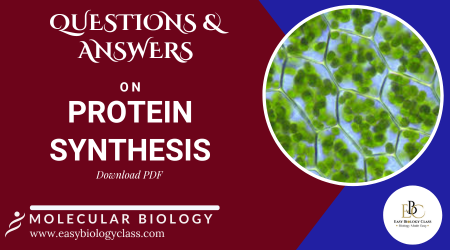Translation is the process by which messenger RNA (mRNA) is decoded into a sequence of amino acids to form a functional protein. This process occurs in the ribosomes, which can be found in the cytoplasm or attached to the rough endoplasmic reticulum in eukaryotes. Translation is the second step in gene expression, following transcription. It involves various key molecules, including transfer RNA (tRNA), ribosomal RNA (rRNA), and several initiation, elongation, and termination factors. Accurate translation is essential for the production of proteins that carry out numerous cellular functions, from catalysis to structural support. This post is about Protein Synthesis Questions and Answers. You can download the questions and answers as PDF from the download link below.
Molecular Biology Notes | Molecular Biology PPTs | Molecular Biology MCQs
Protein Synthesis Questions and Answers
1. What are the main stages of translation?
Translation occurs in three stages: initiation, elongation, and termination. In initiation, the small ribosomal subunit binds to the mRNA and the initiator tRNA, followed by the joining of the large subunit. During elongation, amino acids are sequentially added to the growing polypeptide chain as tRNAs deliver specific amino acids. In termination, a stop codon signals the release of the newly formed polypeptide and the disassembly of the ribosomal complex.
2. How does the ribosome identify the start codon on the mRNA?
In eukaryotes, the small ribosomal subunit binds to the 5′ cap of the mRNA and scans along the mRNA until it identifies the start codon (AUG), which codes for methionine. In prokaryotes, the ribosome binds to the Shine-Dalgarno sequence near the start codon. The initiator tRNA, carrying methionine (or formylmethionine in prokaryotes), pairs with the start codon to begin protein synthesis.
3. What role do tRNAs play in translation?
tRNAs serve as adaptors that carry amino acids to the ribosome. Each tRNA molecule has an anticodon region that pairs with the corresponding codon on the mRNA, ensuring the correct amino acid is added to the growing polypeptide chain. The aminoacyl-tRNA synthetase enzyme attaches the appropriate amino acid to its tRNA, ensuring high fidelity in translation.
4. What is the function of ribosomal RNA (rRNA) in translation?
rRNA forms the core structural and catalytic components of ribosomes. It facilitates the correct alignment of mRNA and tRNAs within the ribosome and catalyzes the formation of peptide bonds between amino acids during elongation. rRNA is essential for the ribosome’s ability to translate mRNA into a functional protein.

5. How is translation terminated?
Translation is terminated when the ribosome encounters a stop codon (UAA, UAG, or UGA) on the mRNA. No tRNA corresponds to these stop codons; instead, release factors bind to the ribosome, causing the polypeptide chain to be released. The ribosomal subunits then dissociate from the mRNA, completing the translation process.
6. What are the roles of elongation factors in translation?
Elongation factors are proteins that assist in the elongation stage of translation. They ensure the correct tRNA binds to the ribosome, facilitate the translocation of the ribosome along the mRNA, and ensure proper energy utilization through GTP hydrolysis. These factors increase the efficiency and accuracy of the translation process.
7. What is a polyribosome, and what is its significance in translation?
A polyribosome (or polysome) is a complex of multiple ribosomes simultaneously translating a single mRNA molecule. This allows for the production of multiple copies of the same protein from one mRNA, increasing the efficiency of protein synthesis. Polyribosomes are commonly found in both prokaryotes and eukaryotes.
8. How do prokaryotic and eukaryotic translation differ?
Prokaryotic translation can begin while transcription is still occurring, as both processes take place in the cytoplasm. Eukaryotic translation, however, is separated from transcription by the nuclear membrane, and mRNA must be fully processed before translation. Additionally, the initiation mechanisms differ, with prokaryotes using a Shine-Dalgarno sequence and eukaryotes relying on a 5′ cap structure for ribosome binding.
9. What are the key features of the genetic code?
The genetic code is universal, degenerate, and non-overlapping. Universal means that nearly all organisms use the same code for translating mRNA into proteins. Degenerate means that multiple codons can code for the same amino acid, providing redundancy. Non-overlapping means that each nucleotide is part of only one codon and is read sequentially during translation.
10. How does wobble base pairing affect translation?
Wobble base pairing allows for flexibility in the pairing between the third nucleotide of a codon and the corresponding anticodon of tRNA. This flexibility enables one tRNA to recognize multiple codons that code for the same amino acid, contributing to the redundancy of the genetic code. Wobble pairing helps optimize the efficiency of protein synthesis.
11. What is the significance of the A, P, and E sites in the ribosome?
The ribosome has three key sites for tRNA binding: the A (aminoacyl) site, the P (peptidyl) site, and the E (exit) site. The A site is where incoming tRNA molecules bind to the mRNA. The P site holds the tRNA carrying the growing polypeptide chain. The E site is where the tRNA, now without an attached amino acid, exits the ribosome. These sites facilitate the orderly addition of amino acids to the polypeptide chain.
12. What is the role of GTP in the translation process?
GTP (guanosine triphosphate) provides energy for several steps in translation, including tRNA binding to the ribosome and ribosome translocation along the mRNA. Elongation factors use GTP to facilitate the correct positioning of tRNA and to move the ribosome from one codon to the next. GTP hydrolysis is essential for the energy-intensive process of protein synthesis.
13. How are post-translational modifications important for protein function?
Post-translational modifications (PTMs) are chemical changes made to a protein after its synthesis. These modifications can include phosphorylation, glycosylation, methylation, and ubiquitination, among others. PTMs play a critical role in regulating protein activity, stability, localization, and interactions with other molecules, making them essential for proper protein function.
14. What is the role of signal peptides in translation?
Signal peptides are short amino acid sequences that direct newly synthesized proteins to specific cellular locations, such as the endoplasmic reticulum (ER) or mitochondria. These peptides are typically located at the N-terminus of the protein and are recognized by signal recognition particles (SRPs). The SRP directs the ribosome to the ER membrane, where translation continues and the protein is inserted into or translocated across the membrane.
15. What is the significance of codon-anticodon recognition in translation fidelity?
The accuracy of translation relies on the correct pairing between the codon on mRNA and the anticodon on tRNA. Codon-anticodon recognition ensures that the proper amino acid is incorporated into the growing polypeptide chain. Mismatches or errors in this pairing can lead to the incorporation of incorrect amino acids, potentially resulting in malfunctioning proteins or disease.
<<< Back to Molecular Biology Notes
I hope you found this Questions and Answers on Protein Synthesis is informative and beneficial. Your feedback and comments would be greatly appreciated. Whether you have suggestions, questions, or thoughts to share, I would be delighted to hear from you. Engaging with your comments helps me continue to produce high-quality content in Biology. Please feel free to leave a comment below. Thank you for your support.
Regards: Admin, EasyBiologyClass
| You may also like NOTES in... | ||
|---|---|---|
| BOTANY | BIOCHEMISTRY | MOL. BIOLOGY |
| ZOOLOGY | MICROBIOLOGY | BIOSTATISTICS |
| ECOLOGY | IMMUNOLOGY | BIOTECHNOLOGY |
| GENETICS | EMBRYOLOGY | PHYSIOLOGY |
| EVOLUTION | BIOPHYSICS | BIOINFORMATICS |
Want to read offline? download full PDF here: Protein Synthesis Questions and Answers
